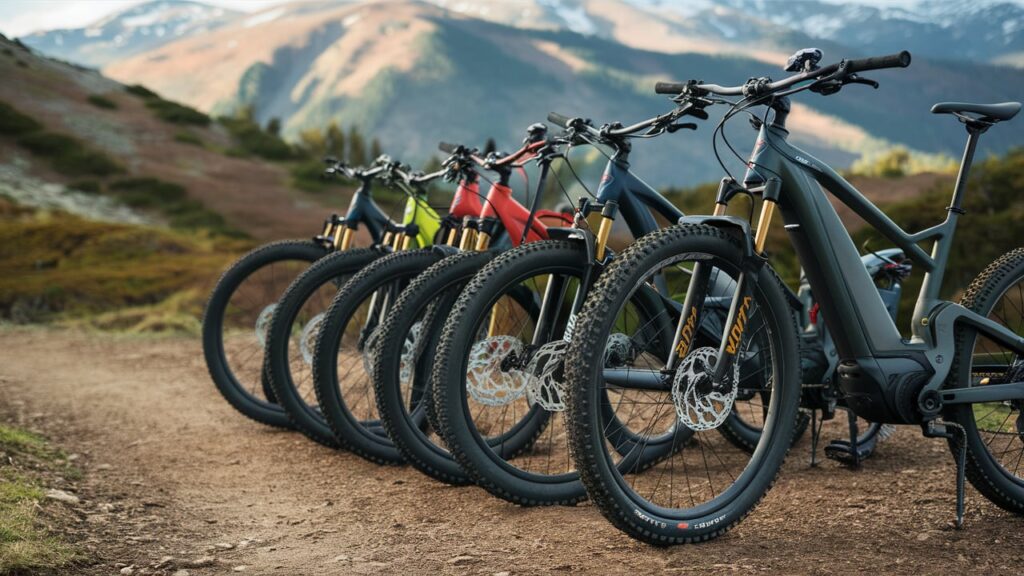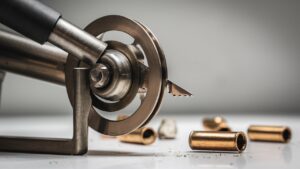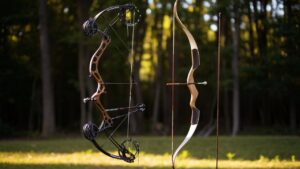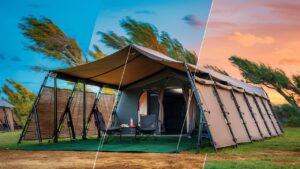Mountain biking offers thrilling adventures on diverse terrains. Understanding bike types and components can enhance your riding experience.
Recommended Best Mountain Bikes 2025
| Recommendation | Product |
| Best Overall | Mongoose Malus Fat Tire Mountain Bike |
| Popular Choice | Schwinn High Timber Mountain Bike |
| Best Value | Mongoose Dolomite Fat Tire Mens Mountain Bike |
| Best Budget | Huffy Stone Hardtail Mountain Bike |
| Another Excellent Pick | UOKAA 29 Inch Mountain Bike |
Choosing the right mountain bike can be overwhelming. Each type serves a different purpose and terrain. From cross-country to downhill, there is a perfect match for every rider. The components also play a crucial role in performance and comfort. Knowing the basics helps you make informed decisions.
This guide will explore various mountain bike types and their components. You will learn about frames, suspensions, brakes, and more. Dive in to discover the essentials and find the best bike for your needs. Let’s get started on your biking journey!
Mountain Bike Types
Mountain biking offers many experiences, and choosing the right type is key. Different bikes cater to various terrains and riding styles. Understanding the types of mountain bikes helps in selecting the right one for your needs.
Cross Country Bikes
Cross country bikes, or XC bikes, excel in climbing and long rides. They are lightweight and focus on speed and efficiency. Ideal for smoother trails, they offer quick handling and acceleration. XC bikes usually have suspension travel between 80-100mm, making them perfect for endurance and racing.
Trail Bikes
Trail bikes are the most versatile mountain bikes. They balance climbing ability and descending performance. These bikes usually have suspension travel of 120-150mm. They are great for varied terrain, from technical climbs to steep descents. Trail bikes offer a good mix of stability and agility.
Enduro Bikes
Enduro bikes are built for rugged terrains and long descents. They feature more suspension travel, typically between 150-170mm. These bikes handle aggressive riding and technical trails well. Enduro bikes are heavier but provide superior control on downhill sections. They are suitable for riders who enjoy challenging trails and high speeds.
Downhill Bikes
Downhill bikes are designed for extreme descents. They have the most suspension travel, usually around 200mm. These bikes are heavy and robust, built to handle jumps and rough terrain. Downhill bikes are not ideal for climbing. They are perfect for lift-assisted or shuttle runs, focusing on descending at high speeds with maximum control.
Frame Materials
Choosing the right frame material for your mountain bike is crucial. It affects weight, durability, and ride quality. Different materials offer unique benefits. Let’s dive into the common types.
Aluminum Frames
Aluminum frames are popular for mountain bikes. They are light and affordable. Aluminum is resistant to rust. It’s a good choice for riders who want a strong, light frame without spending a lot.
Carbon Fiber Frames
Carbon fiber frames are known for being lightweight. These frames provide excellent shock absorption. They are more expensive than aluminum. Carbon fiber is ideal for serious riders who seek performance and comfort.
Steel Frames
Steel frames offer durability and comfort. They are heavier than aluminum and carbon fiber. Steel frames are less prone to breaking. They are perfect for long-distance rides and rough terrains.
Titanium Frames
Titanium frames are premium options. They combine the best features of other materials. Titanium is light, strong, and rust-resistant. These frames offer a smooth ride. They are often used by professional riders.
Suspension Systems
Choosing the right suspension system for your mountain bike can make or break your trail experience. Whether you’re tackling rocky terrains or smooth pathways, the suspension system is crucial for comfort and control. Let’s dive into the different types of suspension systems available and their components.
Hardtail Bikes
Hardtail bikes feature a suspension fork at the front but have a rigid rear end. This setup is perfect for less technical trails and cross-country rides. With fewer moving parts, hardtail bikes are lighter and require less maintenance.
One summer, I switched to a hardtail bike for a cross-country race. The lightweight design and efficient power transfer made climbing hills easier. If you’re new to mountain biking or focusing on speed, a hardtail bike could be your best bet.
Full-suspension Bikes
Full-suspension bikes come with both front and rear suspension. They offer better shock absorption, making them ideal for rough terrains and downhill rides. Although heavier than hardtails, the added comfort and control can be worth it.
On a group ride through rocky trails, my friend’s full-suspension bike effortlessly handled the bumps and drops. She enjoyed a smoother ride and less fatigue. If you plan to tackle challenging trails, consider investing in a full-suspension bike.
Have you tried both types of bikes? Which one do you prefer? Consider your riding style and trail conditions before making a choice. The right suspension system can elevate your mountain biking experience.

Wheel Sizes
Mountain bike wheel sizes vary from 26 to 29 inches. Different sizes offer unique benefits for control and speed. Choosing the right wheel size enhances your biking experience.
Understanding wheel sizes is crucial when choosing the right mountain bike for you. The size of your wheels affects your bike’s performance, handling, and the overall ride experience. Let’s break down the common wheel sizes: 26-inch, 27.5-inch, and 29-inch, to help you make an informed decision.
26-inch Wheels
26-inch wheels were once the standard in mountain biking. They are great for riders who prefer a more agile and nimble ride. With these wheels, you can easily maneuver through tight trails and sharp turns.
These wheels are lighter, making them easier to accelerate. If you’re into trick riding or need a bike that’s quick to respond, 26-inch wheels could be your best bet.
However, they might not roll as efficiently over obstacles compared to larger wheels. Consider your riding style and terrain when thinking about 26-inch wheels.
27.5-inch Wheels
27.5-inch wheels, also known as 650b, offer a balanced ride. They combine the agility of 26-inch wheels with some of the rolling advantages of 29-inch wheels. This middle-ground size is increasingly popular among mountain bikers.
You’ll notice better traction and control with 27.5-inch wheels, especially on rough terrains. They handle obstacles more smoothly than 26-inch wheels, giving you a comfortable ride.
If you’re looking for versatility, 27.5-inch wheels can be a good choice. They work well for both technical trails and longer rides.
29-inch Wheels
29-inch wheels are known for their excellent rollover capability. They can handle rocks, roots, and other obstacles with ease. This makes them ideal for cross-country and trail riding.
With 29-inch wheels, you get increased stability and a smoother ride. They maintain momentum well, which is great for long-distance rides.
On the flip side, these wheels can feel less agile and take longer to accelerate. If you prioritize speed and stability over nimbleness, 29-inch wheels might suit your needs.
Choosing the right wheel size depends on your riding style, terrain, and personal preference. Think about what’s most important to you in a ride. Do you prefer agility and quick response, or do you value stability and smoothness? Your answers will guide you to the perfect wheel size for your mountain biking adventures.
Drivetrain Components
When talking about mountain bikes, the drivetrain is the heart of your ride. It propels you forward, allowing you to navigate steep hills and challenging trails. Understanding the drivetrain components can help you make better choices when upgrading or maintaining your bike.
Chainring And Crankset
The chainring and crankset are the core of your drivetrain. The chainring, a circular component with teeth, grabs the chain and transfers power from your pedals to the wheels. The crankset includes the crank arms, which connect the pedals to the chainring.
When I first started mountain biking, I didn’t realize the impact of the number of chainrings. A single chainring setup is simpler and lighter, making it easier to shift gears. However, multiple chainrings offer a wider range of gears, which is useful for varied terrain.
Think about your riding style. If you enjoy technical trails with lots of climbing, you might prefer the simplicity of a single chainring. For diverse trails, a double or triple chainring could be more suitable. What’s your preference?
Derailleur Systems
The derailleur system is crucial for shifting gears smoothly. It consists of the front and rear derailleurs, which move the chain between different chainrings and cogs. The front derailleur shifts the chain on the chainrings, while the rear derailleur handles the cogs on the cassette.
In my early days, I struggled with gear shifting until I upgraded to a high-quality derailleur system. A good derailleur can make a significant difference in performance and ease of use. Regular maintenance is key, though. Keep your derailleurs clean and well-lubricated to ensure smooth shifting.
Consider your skill level and how often you ride. An advanced rider might opt for a more sophisticated derailleur system, whereas beginners might prefer something simpler and more durable. What type of rider are you?
Cassette And Chain
The cassette is a cluster of cogs attached to the rear wheel. It works with the chain to provide a range of gears. The chain connects all these components, transferring power from the pedals to the wheels.
When choosing a cassette, pay attention to the number of cogs and their range. A wider range offers more gear options, which is helpful for varied terrain. I remember switching to a wider range cassette and suddenly being able to tackle steep climbs more easily.
The chain’s quality is just as important. A well-maintained chain ensures efficient power transfer and prolongs the life of your drivetrain. Regular cleaning and lubrication are essential. How often do you check your chain?
Understanding these drivetrain components can transform your mountain biking experience. Whether you’re climbing steep hills or cruising down trails, having the right setup is crucial. What upgrades or maintenance does your bike need?
Braking Systems
Mountain bike braking systems are crucial for control and safety. Types include disc brakes and rim brakes, each with unique advantages. Components like brake levers, calipers, and pads work together to provide efficient stopping power.
Mountain biking demands reliable braking systems for safety and control. Different types of brakes cater to various riding styles and conditions. Understanding these can enhance your biking experience. Below, we explain the two main types: rim brakes and disc brakes.
Rim Brakes
Rim brakes are common in many mountain bikes. They consist of brake pads that press against the wheel rims. These brakes are lightweight and simple. They are easy to maintain. Rim brakes are effective in dry conditions. However, they can struggle in wet or muddy environments. They also wear down the wheel rims over time.
Disc Brakes
Disc brakes offer superior stopping power. They use a rotor attached to the wheel hub. Brake pads press against this rotor. Disc brakes perform well in all weather conditions. They are less affected by mud or water. There are two types: mechanical and hydraulic. Mechanical disc brakes use cables. Hydraulic disc brakes use fluid for better modulation. They require more maintenance but offer precise control. Disc brakes are heavier than rim brakes but provide better performance.
Handlebars And Stems
Handlebars and stems are crucial components of a mountain bike. They affect your comfort and control. Different types of handlebars offer unique advantages. Stems vary in length and can change your riding experience. Let’s explore these elements further.
Flat Bars
Flat bars are straight and simple. They provide a low, aggressive riding position. Ideal for speed and control. Many racers prefer flat bars. They offer precise steering. Great for cross-country trails. Easy to navigate tight spaces.
Riser Bars
Riser bars have a slight upward curve. They provide a more upright riding position. This reduces strain on your back and wrists. Perfect for long rides. Ideal for trail and all-mountain biking. More comfortable and relaxed. Better for rough terrains.
Stem Lengths
Stem lengths vary and impact handling. Short stems offer quick steering. Great for technical trails. Long stems provide stability. Better for straight paths. Choose stem length based on your riding style. It can enhance your overall experience.
Tires And Tubes
Mountain bike tires and tubes play a crucial role in your biking experience. They impact your grip, speed, and comfort on different terrains. Let’s explore the key aspects of mountain bike tires and tubes.
Tire T Tread Patterns
Tire tread patterns vary based on the riding surface. For muddy trails, choose tires with deep, aggressive treads. These treads help in shedding mud and maintaining grip. For rocky terrain, opt for tires with smaller, closely spaced knobs. They provide better control and traction on hard surfaces. For smoother trails or road biking, slick or semi-slick tires are suitable. They offer less rolling resistance, making your ride faster and more efficient.
Tubeless Tires
Tubeless tires are becoming popular among mountain bikers. They do not have inner tubes, reducing the risk of punctures. Tubeless tires also allow for lower air pressure. This improves traction and comfort on rough terrains. They are more complex to set up initially, but the benefits are worth it. You will need tubeless-ready rims and proper sealant to make them work.
Inner Tubes
Inner tubes are the traditional choice for mountain bike tires. They sit inside the tire and hold the air. Tubes are easy to install and replace. They are also less expensive than tubeless setups. However, they are more prone to punctures. Always carry a spare tube and a pump for emergencies. Choose the right tube size and valve type for your bike for the best performance.
Frequently Asked Questions
What Are The Different Types Of Mountain Bikes?
There are several types of mountain bikes: cross-country (XC), trail, all-mountain (enduro), downhill, fat bikes, and dirt jump bikes.
What Is Enduro Vs Xc?
Enduro focuses on long, technical descents with timed stages. XC (cross-country) emphasizes endurance on varied terrains with continuous pedaling.
Is It Better To Have 27.5 Or 29 Mtb?
Choose a 27. 5 MTB for agility and maneuverability. Opt for a 29 MTB for better speed and stability on rough terrain.
Should I Buy A Hardtail Or Full-suspension Mountain Bike?
Choose a hardtail for smoother trails and lower cost. Opt for a full-suspension bike for rougher terrain and better comfort. Your choice depends on your riding style and budget.
Conclusion
Choosing the right mountain bike is essential. Understand the types and components well. This will improve your biking experience. Consider your riding style and terrain. Research different bike models and brands. Test ride if possible. Make an informed decision. Enjoy the trails with confidence.
Happy biking!








